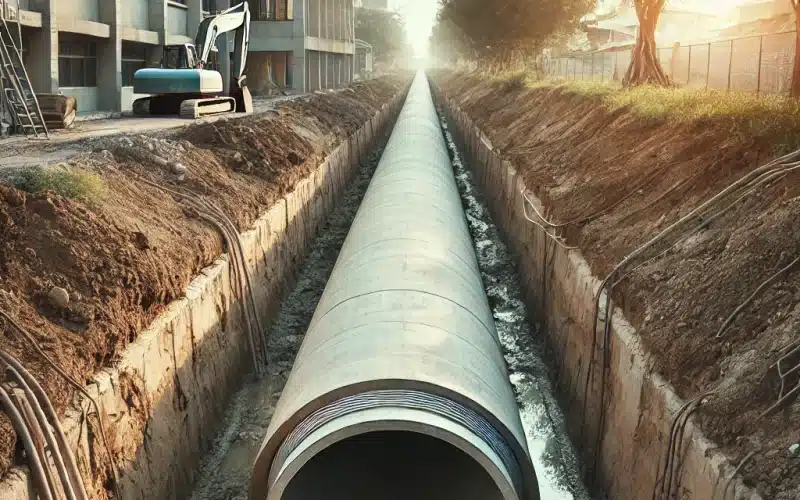
Today we talk about a passive cooling/heating system which is less used, but which has some interesting advantages: Earth Wind Tunnels, also known as Earth Air Tunnels (EATs). This cooling/heating system utilizes the Earth’s stable subterranean temperature to pre-condition air for cooling or heating a building.
How do Earth Air Tunnels Work?
Air is drawn through a series of underground pipes, where it exchanges heat with the surrounding soil. This results in cooled air in summer and warmed air in winter before it enters the building.
To achieve this, EATs use a series of underground pipes to pre-condition air before it enters a building. Here’s a step-by-step overview of the process:
- Installation: Pipes are installed 1.5-3 meters below ground level, made from durable materials like PVC or metal to ensure effective heat conduction.
- Air Intake: Outside air is drawn into the tunnel through an intake structure.
- Air Movement: Fans or natural convection move the air through the underground pipes.
- Temperature Regulation: As the air travels through the pipes, it exchanges heat with the surrounding soil. In summer, the cooler earth cools the air, while in winter, the warmer earth heats it.
- Air Delivery: The conditioned air is then delivered into the building, reducing the need for mechanical heating and cooling systems.
Benefits and Drawbacks of Earth Air Tunnels
Earth Wind Tunnels provide several advantages. They significantly reduce energy consumption by leveraging natural thermal properties, leading to lower utility bills and a reduced carbon footprint. The system offers consistent indoor temperatures, enhancing comfort without the fluctuations common in conventional HVAC systems. Maintenance requirements are minimal due to the lack of moving parts, which also contributes to long-term cost savings. Additionally, they utilize renewable energy, aligning with sustainability goals.
Despite their benefits, Earth Wind Tunnels have certain drawbacks. Installation costs are high due to the need for excavation and specialized materials. Proper design is crucial to prevent issues such as condensation, mold growth, and thermal saturation of the surrounding soil. The effectiveness of these systems depends on local soil conditions and climate, limiting their applicability in certain regions. They also require regular maintenance to ensure optimal performance and air quality.
It’s also crucial to know that Earth Wind Tunnels can lose efficiency if soil around them becomes thermally saturated. Proper design and flow rates are essential.
Next to this, there are a few extra issues which need proper scrutiny and preparation in order to make sure your health is not at risk:
- Radon: Earth Wind Tunnels can channel radon into homes if not properly sealed or designed. Use solid, sealed pipes and ensure proper airflow to mitigate risks.
- Mold: Condensation and improper drainage can lead to mold growth. Use smooth, non-organic materials like HDPE pipes and design for good airflow and drainage to avoid moisture buildup.
- Humidity: In hot, humid climates, Earth Wind Tunnels can increase indoor humidity. Proper dehumidification systems are necessary.
Optimal Locations for Earth Air Tunnels
You can naturally heat your house with the help of earth air tunnels. pic.twitter.com/aUnAQy1VVf
— 07Sketches (@The07Sketches) March 16, 2024
The effectiveness of EATs depends on regional climate, soil type, and temperature variations. Here are some key regions where EATs are most suitable:
- Temperate Climates: Ideal regions include the Midwest and Northeast United States, Southern Canada, Germany, France, and the UK, where seasonal temperature differences are significant .
- Mediterranean Climates: Southern Europe (Spain, Italy, Greece) and California benefit from hot summers and mild winters, ideal for EATs .
- Continental Climates: Central Asia (Kazakhstan, Mongolia) and Eastern Europe (Poland, Ukraine, Russia) have extreme seasonal temperature variations, suitable for EATs .
- Subtropical Climates: Southeastern Australia and parts of China (Shanghai, Beijing) also support EAT installations
Why are Earth Air Tunnels Not more Widely Used?
Despite their advantages, several factors limit the widespread use of EATs.
The initial cost of installing an Earth Wind Tunnel system can be prohibitive for some. Costs vary based on the complexity of the installation, local labor rates, and material prices. However, the long-term savings on energy bills and the system’s durability can offset these initial expenses over time.
Let’s have a look at the total list of factors that limit its use for now.
- High Initial Costs: The installation of EAT systems requires significant upfront investment in excavation and materials .
- Design and Implementation Challenges: Effective EAT systems need precise design and engineering, tailored to specific site conditions and climates .
- Limited Awareness and Knowledge: Many professionals and potential users are unaware of EATs and their benefits. Additionally, there is a lack of educational resources and training on designing and implementing these systems .
- Geographical Limitations: Not all regions have suitable soil or climate conditions for efficient EAT operation .
- Regulatory and Permitting Hurdles: Building codes and environmental regulations can complicate the approval and installation of EATs .
- Maintenance Concerns: Potential issues like condensation, mold, and pests require careful design and regular maintenance .
- Competing Technologies: Established HVAC systems are more widely understood and easier to implement. Advancements in conventional HVAC technologies have also reduced the perceived need for alternatives like EATs . However, in several EU countries the energy costs to maintain heat pumps makes that EATS could be a more solid solution.
Effective, Sustainable but High Initial Cost
Earth Wind Tunnels provide an effective, sustainable solution for climate control in suitable regions. They offer energy efficiency and comfort with lower environmental impact. However, high installation costs and specific design requirements can be challenging.
